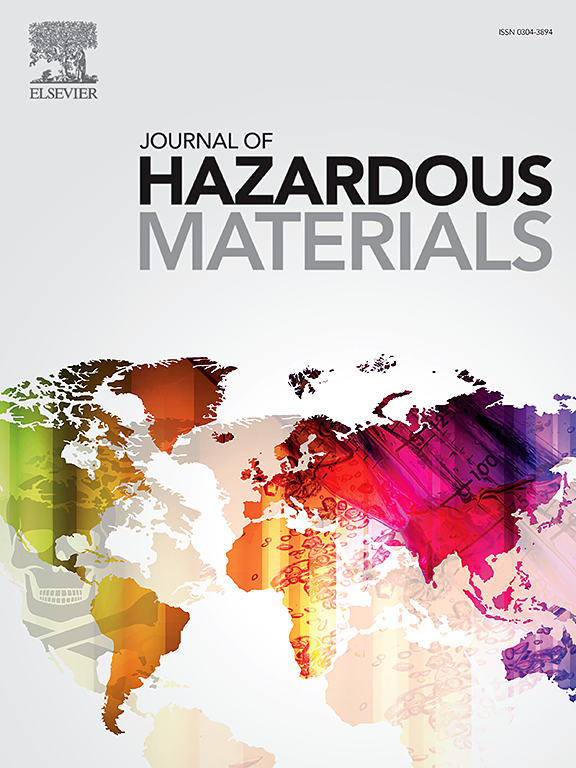Structural-Interfacial Engineering of MOF-functionalized Aerogels for Efficient Photocatalytic Reduction of Cr(VI)
IF 12.2
1区 环境科学与生态学
Q1 ENGINEERING, ENVIRONMENTAL
引用次数: 0
Abstract
Hexavalent chromium (Cr(VI)) contamination poses severe ecological risks due to its carcinogenicity and prevalence in industrial wastewater, where metal-organic frameworks (MOFs) show photocatalytic remediation potential. However, powdered MOFs suffer from poor recyclability and secondary pollution risks in practical applications. This study proposes an integrated structural-interfacial engineering strategy that combines the design of a robust three-dimensional fiber network framework with the interfacial engineering of MOFs and cellulose nanofibers to fabricate robust MOF-functionalized aerogel (MOFA) photocatalyst. The MOFAs feature hierarchical coordination effects enabling precise MOF crystallization control, achieving ultrahigh MOF loading (76.77 wt%), mechanical robustness (29 kPa stress at 70% compression), exceptional stability (6.7% permanent deformation after 100 cycles), and enhanced photocatalytic activity (photocurrent density of 2.87 μA/cm²). The optimized interfacial structure delivers superior adsorption (67%) and photocatalytic performance (100% Cr(VI) reduction in 80 minutes, >94% efficiency retention after 5 cycles), validated across diverse water matrices including high-salinity tanning wastewater under outdoor conditions. This innovative strategy offers a new design approach for developing high-performance photocatalytic materials and holds important application prospects in environmental governance.

mof功能化气凝胶高效光催化还原Cr(VI)的结构-界面工程
六价铬(Cr(VI))污染因其致癌性和在工业废水中的普遍存在而造成严重的生态风险,金属有机框架(MOFs)在工业废水中具有光催化修复潜力。但在实际应用中,粉末状MOFs存在可回收性差和二次污染风险。本研究提出了一种集成的结构-界面工程策略,将坚固的三维纤维网络框架设计与mof和纤维素纳米纤维的界面工程相结合,以制造坚固的mof功能化气凝胶(MOFA)光催化剂。mofa具有分层协调效应,可实现精确的MOF结晶控制,实现超高的MOF负载(76.77 wt%),机械鲁棒性(70%压缩时29 kPa应力),卓越的稳定性(100次循环后6.7%的永久变形),以及增强的光催化活性(光电流密度为2.87 μA/cm²)。优化后的界面结构具有优异的吸附(67%)和光催化性能(80分钟内Cr(VI)还原100%,5个循环后效率保持94%),在不同的水基质中得到验证,包括在室外条件下的高盐度鞣制废水。这一创新策略为开发高性能光催化材料提供了新的设计途径,在环境治理中具有重要的应用前景。
本文章由计算机程序翻译,如有差异,请以英文原文为准。
求助全文
约1分钟内获得全文
求助全文
来源期刊

Journal of Hazardous Materials
工程技术-工程:环境
CiteScore
25.40
自引率
5.90%
发文量
3059
审稿时长
58 days
期刊介绍:
The Journal of Hazardous Materials serves as a global platform for promoting cutting-edge research in the field of Environmental Science and Engineering. Our publication features a wide range of articles, including full-length research papers, review articles, and perspectives, with the aim of enhancing our understanding of the dangers and risks associated with various materials concerning public health and the environment. It is important to note that the term "environmental contaminants" refers specifically to substances that pose hazardous effects through contamination, while excluding those that do not have such impacts on the environment or human health. Moreover, we emphasize the distinction between wastes and hazardous materials in order to provide further clarity on the scope of the journal. We have a keen interest in exploring specific compounds and microbial agents that have adverse effects on the environment.
 求助内容:
求助内容: 应助结果提醒方式:
应助结果提醒方式:


